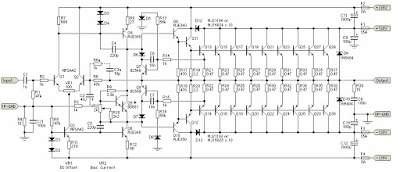Transformer 2 x 90V will give no-load voltage ± 130V (260V between the outermost points of the rectifier), so that the power supply to operate with extreme caution.
Bipolar transistors were chosen as most appropriate for end-stage of the amplifier. This is primarily dictated by the voltage that exceeds the boundary voltage for the majority of MOSFET transistors. It’s as much and for bipolar transistors, but MJ15004 / 5, or MJ21193 / 4 correspond to the maximum voltage requirement, and therefore, we shall discuss them.
Next, you need to think about the dissipation of excess capacity on the transistors and the intensity of their cooling. Since at 65V under load (worst case) power dissipation will be …
P = V? / R = 65? / 4 = 1056W
That is equal to the average electric heaters …
Remember, when working on a resistive load with 45 ° phase shifts power dissipation is almost doubled. From this it follows that a good cooling is essential for this amplifier, you need a good radiator, cooling fans for forced cooling (natural convection does not help).
MJ15024 / 5 (or MJ21193 / 4) transistors in the case of K-3 (iron with two pins as KT825/827), and calculated to scatter 250W at 25 ° C. Housing K-3 transistor chosen because it has the highest rated power dissipation, because the thermal resistance is lower than that of any other transistor in a plastic case.
MJE340/350 in the voltage amplifier stage provides good linearity. But even with the current through a cascade of 12mA, Power – 0.72W, so that Q4, Q6, Q9 and Q10 must have heat sinks. Transistor (Q5), the offset bias adjustment must be installed on a common heat sink with okonechnikom and a reliable thermal contact.
Short-circuit protection circuit (Q7, Q8) limits the current at 12A and the power is allocated one transistor around 175W, while long-term operation of the amplifier in this mode is not allowed.
Additional elements of the feedback (R6a and C3a, as shown dotted) are optional. They may be needed in case of self amplifier. Backward diodes (D9 and D10) to protect the transistors of the amplifier back-EMF at work on a resistive load. Diodes 1N5404 series can withstand peak currents up to 200A. Rated voltage should be at least 400V.
Resistor VR1 100 Omo used for balancing the DC amplifier. With component values shown in the diagram, the initial offset must be within ± 25mV, before setting up. Resistor VR2 is used to set the quiescent current bias adjustment. Adjust the idle current by measuring the voltage across the resistor R19 or R20 which should be within 150mV. Sensitivity input stage – 1.77V for 900W into 8 ohms, or 1800W into 4 ohms.

0 Response to "1500W Power Amplifier Circuit"
Post a Comment